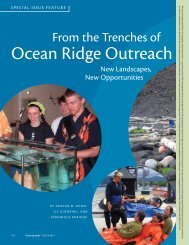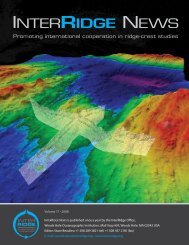Full version, low resolution, 7.5MB - InterRidge
Full version, low resolution, 7.5MB - InterRidge
Full version, low resolution, 7.5MB - InterRidge
You also want an ePaper? Increase the reach of your titles
YUMPU automatically turns print PDFs into web optimized ePapers that Google loves.
National News<br />
Korea<br />
Sung-Hyun Park<br />
Korea completed three ridge-related cruises on the Antarctic,<br />
Western Pacific and Indian Oceans. The good news is that KOPRI<br />
is starting a large three-year project on the exploration of the<br />
Australian-Antarctic Ridge (South of Tasmania). We are planning<br />
two more cruises on the Australian-Antarctic Ridge including AUV<br />
surveys.<br />
1) Australian-Antarctic Ridge<br />
KOPRI (Korea Polar Research Institute) conducted a research cruise<br />
on one segment (KR1) of the Australian-Antarctic Ridge in<br />
December 2011. 32 MAPRs and rock cores were done and a<br />
hydrothermal vent site was located more precisely. Also a multibeam<br />
map was expanded around the axis. We tried CTD sampling<br />
from a potential vent site and found the signals of methane and<br />
3He. The next cruise is scheduled in Jan-Feb 2013, and we will try<br />
more CTDs, camera tows and dredges.<br />
2) Central Indian Ridge<br />
KORDI (Korea Ocean Research Institute) performed an<br />
exploration for hydrothermal vents along the northern Central<br />
Indian Ridge (CIR), 8º-12ºS in November-December 2011. The<br />
exploration was focused on the identification of a location of<br />
hydrothermal plumes that were investigated by previous cruises<br />
using CTD Toyo attached with MAPRs. During the survey, at least<br />
8 hydrothermal plumes were identified along the 7 ridge segments<br />
of the northern CIR. Most plume signals were hosted by ultramafic<br />
rocks exposed on the seafloor by the formation of Ocean Core<br />
Complexes (OCC).<br />
3) Tonga Arc<br />
ROV (ROPOS of CSSF) surveys were performed along the<br />
hydrothermal vents on the two seamounts of Tonga Arc in January-<br />
February 2012. Detailed bathymetric data were obtained by<br />
ROV-mounted multibeam survey in the 1st leg. Visual surveys and<br />
sampling of active and inactive hydrothermal vents were performed<br />
in the second leg. During the ROV survey, more than 100 individual<br />
hydrothermal vents were observed in the two submarine calderas.<br />
Mauritius<br />
Daniel E.P. Marie<br />
Recent joint collaborations between scientists of the Mauritius<br />
Oceanography Institute (MOI), Japan Agency for Marine-Earth<br />
Science and Technology (JAMSTEC) and University of Tokyo have<br />
resulted in the discovery of new hydrothermal sites on the Central<br />
Indian Ridge (http://www.plosone.org/article/ info%3Adoi%2F10.<br />
1371%2Fjournal.pone.0032965). Further geological and biological<br />
investigations have been undertaken since then. Thus the existence<br />
of four known hydrothermal sites on the Central Indian Ridge (CIR)<br />
provided a unique opportunity to look at the ecological settings as<br />
well as faunal composition. Preliminary results have also been<br />
presented during the 7th WIOMSA Symposium held in Mombasa,<br />
Kenya (24 th - 29 th October 2011) with the title “Biodiversity at<br />
Hydrothermal Vents along Central Indian Ridge Revised: New<br />
Discoveries, New Perspectives”. Recent data analysis by Mr. Girish<br />
Beedessee (MOI), Dr. Hiromi Watanabe (JAMSTEC) and Dr. Ken<br />
Takai (JAMSTEC) has tried to explain the dispersal abilities of<br />
several invertebrates from these four vent sites. The Central Indian<br />
Ridge has been poorly investigated, in terms of its geology and<br />
biology when compared to other ridge systems and such studies aim<br />
to attract the scientific<br />
community for further<br />
explorations within the CIR.<br />
A cruise devoted to re-visit<br />
the new hydrothermal vents<br />
is planned for 2013 and this<br />
collaboration is a fine<br />
example of how scientists<br />
can work together to<br />
unravel the hidden chemical<br />
and ecological diversity. We<br />
hope the next cruise will<br />
bring exciting news,<br />
revealing new insights of<br />
the CIR.<br />
Daniel Marie, Mauritian<br />
National Correspondent for<br />
<strong>InterRidge</strong><br />
INTERRIDGE NEWS 41 VOL.21, 2012
















